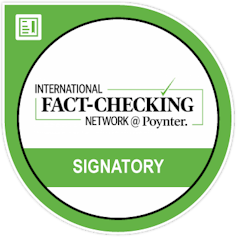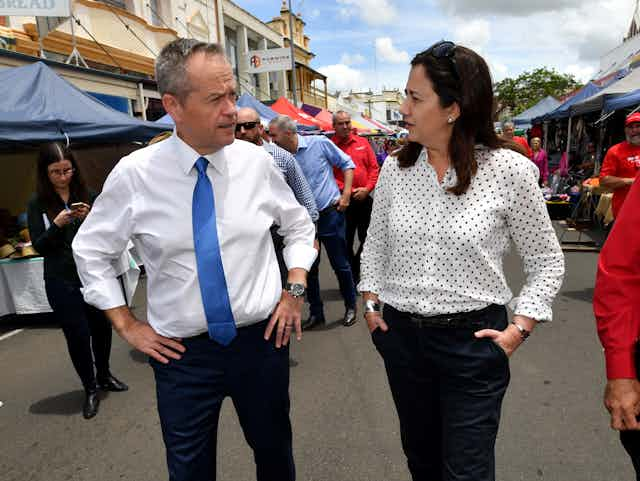… we have created 122,500 jobs – more than four times the number of jobs created under the Newman-Nicholls government. – Queensland Labor Work Ready Queensland policy document, November 2, 2017.
With unemployment in Queensland running above the national average – more than double the national average in some parts of the state – promises and claims about jobs growth are front and centre of the Labor Party campaign.
In a policy document released at the start of the election campaign, Queensland Labor said it had “created 122,500 jobs – more than four times the number of jobs created under the Newman-Nicholls government”.
Are those numbers correct? And can Labor fairly claim to have “created” those jobs?
Checking the source
When asked for sources to support the statement, a spokesperson for Annastacia Palaszczuk pointed The Conversation to Australian Bureau of Statistics trend data for total employed persons from March 2012 to September 2017.
In summary, the spokesperson said that between March 2012 (when Campbell Newman was elected) and January 2015 (when Palaszczuk was elected), job numbers rose by 29,000. This was compared to an increase of 122,500 jobs between January 2015 and September 2017.
The spokesperson noted that 29,000 jobs is “less than one-quarter of 122,500”.
But calculating those numbers is not that simple.
Verdict
Queensland Labor said it had “created 122,500 jobs – more than four times the number of jobs created under the Newman-Nicholls government”.
There is no definitive way to calculate this number. On some measures, the statement is correct. On other measures, it’s an overstatement.
Job numbers increased by somewhere between 117,380 and 122,500 during the Palaszczuk government’s term. That’s between 3.4 and 4.2 times the jobs growth under the Newman government.
Whichever way you look at it, it’s fair to say that employment increased significantly more during the Palaszczuk government’s term than the Newman government’s.
Can Labor claim to have “created” those jobs?
No, that’s not entirely fair. State government policy is only one of many factors that determine employment dynamics. Changes in employment levels are never solely due to the efforts of any one government.
Did Labor ‘create’ 122,500 jobs under Palaszczuk?
We can see how many jobs have been created in Queensland in recent years by looking at Australian Bureau of Statistics labour force data.
The data show that more jobs were created under the Labor government led by Annastacia Palaszczuk than under the Liberal National Party (LNP) government led by Campbell Newman (and in which Tim Nicholls was treasurer).
Exactly how many more jobs were created? Well, that’s not quite as simple to calculate as you might think.
Australian Bureau of Statistics labour force data are available on a monthly basis. To see how employment levels have changed, we look at employment figures in the month before the start of a government, and in the last month of that government.
Newman took office on March 26, 2012. So, March 2012 can be considered the last month before the beginning of the Newman LNP government.
But it’s slightly trickier to match the monthly data against the point when the Newman government ended and the Palaszczuk government began. That’s because we’re working with monthly data, and Palaszczuk took office in the middle of a month – on February 14, 2015.
Palaszczuk’s office told The Conversation they considered January 2015 as the end of the Newman government. That’s consistent with the fact that the election was held on January 31, 2015.
But it also means all the jobs created in the two weeks in February 2015 before Palaszczuk took office are attributed to the Labor government.
So, in the context of looking at monthly employment data, should we could consider February 2015, or January 2015, to be the last month before the beginning of the Palaszczuk government?
In my view, there are arguments for and against both of these options. So I’m going to show you the numbers based on three scenarios:
we attribute jobs growth in February 2015 to the LNP government;
we attribute jobs growth in February 2015 to the Labor government; and
we attribute 50% of the jobs growth to the LNP government, and 50% to Labor.
The numbers presented are until September 2017.
The table shows the outcome of each scenario and the total change in employment. That’s the difference in the total number of people employed at the end and start of the government.
Scenario #1: Labor’s claim is incorrect
If we attribute the jobs growth for February 2015 to the LNP, then Labor’s claim is incorrect. Using this measure, total employment increased by 117,380 under the Palaszczuk government, compared to 34,170 under the Newman government.
That means that 3.4 more times jobs were created under Labor than the LNP – not “more than four times”.
Scenario #2: Labor’s claim is verified
If we attribute the jobs growth for February 2015 to Labor, then the party’s statement is verified: total employment increased by 122,550 under the Palaszczuk government, compared to an increase of 28,990 jobs under the Newman government.
In this scenario, 4.2 more times jobs were created under Labor than LNP – so it is “more than four times”, as Queensland Labor said.
Scenario #3: Labor’s claim is a slight overstatement
If we split the difference – with half of February 2015 allocated to each government – then the data show an increase of 119,960 jobs under the Palaszczuk government, compared to an increase of 31,580 jobs under the Newman government.
That amounts to 3.8 times more jobs under Palaszczuk – below Labor’s original “more than four times” claim, albeit by an economically small margin.
So, what’s the bottom line?
On some measures, the statement is numerically correct. On others, it is a slight overstatement. Either way you look at it, it’s fair to say that employment increased significantly more during the term of the Palaszczuk government.
Can Queensland Labor claim to have ‘created’ these jobs?
No, that’s not entirely fair. State government policy is only one of many factors that determine employment dynamics in a given period of time. Changes in employment levels are never solely due to the efforts of any one government.
Other factors that influence employment levels include (and are certainly not limited to):
federal policies;
economic conditions in trading partner countries;
changes in the international price of commodities; and
variations in the level of the interest rate and/or the exchange rate.
It is difficult to establish with certainty the relative contribution to employment growth of each of these factors. – Fabrizio Carmignani
Blind review
This is a sound and balanced FactCheck.
Whichever approach to measurement is used, the verdict – that total Queensland employment has grown more rapidly under Labor than under the Liberal National Party – is correct.
I agree with the author that there is some difficulty in knowing precisely when to “start the clock” on the Queensland Labor government.
In my view, treating the whole month of February 2015 as part of Labor’s term (as Queensland Labor did in its policy document) is the least convincing approach, as Labor did not begin to govern until the second half of that month. But I commend the author’s thoroughness in showing the numerical consequences of the different approaches in their three scenarios.
The author is correct in pointing out that no government can claim sole responsibility for any change in employment during its term. The political cycle rarely aligns with the economic cycle. I am sceptical about whether any government deserves the full credit – or blame – for economic developments that happen on its watch.
This is especially true of state governments, which are often at the mercy of larger forces. The author rightly mentions the wide array of national and international factors that reach far beyond Queensland’s borders. – Joshua Healy
The Conversation is fact-checking the Queensland election. If you see a ‘fact’ you’d like checked, let us know by sending a note via email, Twitter or Facebook. The Conversation thanks James Cook University for its support.

The Conversation’s FactCheck unit is the first fact-checking team in Australia and one of the first worldwide to be accredited by the International Fact-Checking Network, an alliance of fact-checkers hosted at the Poynter Institute in the US. Read more here.
Have you seen a “fact” worth checking? The Conversation’s FactCheck asks academic experts to test claims and see how true they are. We then ask a second academic to review an anonymous copy of the article. You can request a check at checkit@theconversation.edu.au. Please include the statement you would like us to check, the date it was made, and a link if possible.

